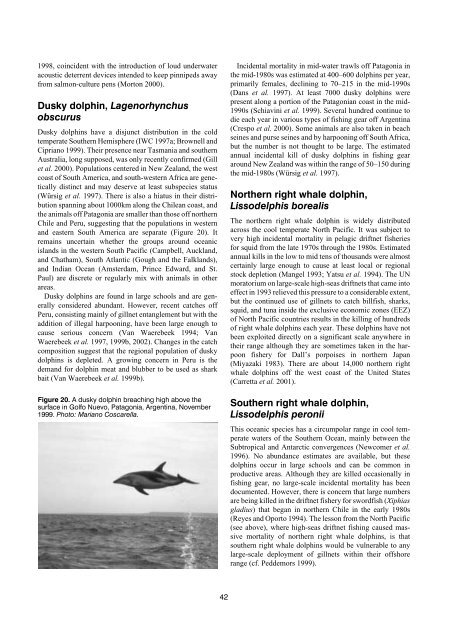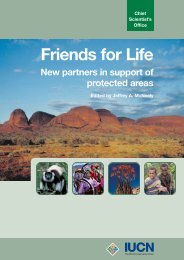Dolphins, Whales and Porpoises: 2002-2010 Conservation - IUCN
Dolphins, Whales and Porpoises: 2002-2010 Conservation - IUCN
Dolphins, Whales and Porpoises: 2002-2010 Conservation - IUCN
Create successful ePaper yourself
Turn your PDF publications into a flip-book with our unique Google optimized e-Paper software.
1998, coincident with the introduction of loud underwater<br />
acoustic deterrent devices intended to keep pinnipeds away<br />
from salmon-culture pens (Morton 2000).<br />
Dusky dolphin, Lagenorhynchus<br />
obscurus<br />
Dusky dolphins have a disjunct distribution in the cold<br />
temperate Southern Hemisphere (IWC 1997a; Brownell <strong>and</strong><br />
Cipriano 1999). Their presence near Tasmania <strong>and</strong> southern<br />
Australia, long supposed, was only recently confirmed (Gill<br />
et al. 2000). Populations centered in New Zeal<strong>and</strong>, the west<br />
coast of South America, <strong>and</strong> south-western Africa are genetically<br />
distinct <strong>and</strong> may deserve at least subspecies status<br />
(Würsig et al. 1997). There is also a hiatus in their distribution<br />
spanning about 1000km along the Chilean coast, <strong>and</strong><br />
the animals off Patagonia are smaller than those off northern<br />
Chile <strong>and</strong> Peru, suggesting that the populations in western<br />
<strong>and</strong> eastern South America are separate (Figure 20). It<br />
remains uncertain whether the groups around oceanic<br />
isl<strong>and</strong>s in the western South Pacific (Campbell, Auckl<strong>and</strong>,<br />
<strong>and</strong> Chatham), South Atlantic (Gough <strong>and</strong> the Falkl<strong>and</strong>s),<br />
<strong>and</strong> Indian Ocean (Amsterdam, Prince Edward, <strong>and</strong> St.<br />
Paul) are discrete or regularly mix with animals in other<br />
areas.<br />
Dusky dolphins are found in large schools <strong>and</strong> are generally<br />
considered abundant. However, recent catches off<br />
Peru, consisting mainly of gillnet entanglement but with the<br />
addition of illegal harpooning, have been large enough to<br />
cause serious concern (Van Waerebeek 1994; Van<br />
Waerebeek et al. 1997, 1999b, <strong>2002</strong>). Changes in the catch<br />
composition suggest that the regional population of dusky<br />
dolphins is depleted. A growing concern in Peru is the<br />
dem<strong>and</strong> for dolphin meat <strong>and</strong> blubber to be used as shark<br />
bait (Van Waerebeek et al. 1999b).<br />
Figure 20. A dusky dolphin breaching high above the<br />
surface in Golfo Nuevo, Patagonia, Argentina, November<br />
1999. Photo: Mariano Coscarella.<br />
42<br />
Incidental mortality in mid-water trawls off Patagonia in<br />
the mid-1980s was estimated at 400–600 dolphins per year,<br />
primarily females, declining to 70–215 in the mid-1990s<br />
(Dans et al. 1997). At least 7000 dusky dolphins were<br />
present along a portion of the Patagonian coast in the mid-<br />
1990s (Schiavini et al. 1999). Several hundred continue to<br />
die each year in various types of fishing gear off Argentina<br />
(Crespo et al. 2000). Some animals are also taken in beach<br />
seines <strong>and</strong> purse seines <strong>and</strong> by harpooning off South Africa,<br />
but the number is not thought to be large. The estimated<br />
annual incidental kill of dusky dolphins in fishing gear<br />
around New Zeal<strong>and</strong> was within the range of 50–150 during<br />
the mid-1980s (Würsig et al. 1997).<br />
Northern right whale dolphin,<br />
Lissodelphis borealis<br />
The northern right whale dolphin is widely distributed<br />
across the cool temperate North Pacific. It was subject to<br />
very high incidental mortality in pelagic driftnet fisheries<br />
for squid from the late 1970s through the 1980s. Estimated<br />
annual kills in the low to mid tens of thous<strong>and</strong>s were almost<br />
certainly large enough to cause at least local or regional<br />
stock depletion (Mangel 1993; Yatsu et al. 1994). The UN<br />
moratorium on large-scale high-seas driftnets that came into<br />
effect in 1993 relieved this pressure to a considerable extent,<br />
but the continued use of gillnets to catch billfish, sharks,<br />
squid, <strong>and</strong> tuna inside the exclusive economic zones (EEZ)<br />
of North Pacific countries results in the killing of hundreds<br />
of right whale dolphins each year. These dolphins have not<br />
been exploited directly on a significant scale anywhere in<br />
their range although they are sometimes taken in the harpoon<br />
fishery for Dall’s porpoises in northern Japan<br />
(Miyazaki 1983). There are about 14,000 northern right<br />
whale dolphins off the west coast of the United States<br />
(Carretta et al. 2001).<br />
Southern right whale dolphin,<br />
Lissodelphis peronii<br />
This oceanic species has a circumpolar range in cool temperate<br />
waters of the Southern Ocean, mainly between the<br />
Subtropical <strong>and</strong> Antarctic convergences (Newcomer et al.<br />
1996). No abundance estimates are available, but these<br />
dolphins occur in large schools <strong>and</strong> can be common in<br />
productive areas. Although they are killed occasionally in<br />
fishing gear, no large-scale incidental mortality has been<br />
documented. However, there is concern that large numbers<br />
are being killed in the driftnet fishery for swordfish (Xiphias<br />
gladius) that began in northern Chile in the early 1980s<br />
(Reyes <strong>and</strong> Oporto 1994). The lesson from the North Pacific<br />
(see above), where high-seas driftnet fishing caused massive<br />
mortality of northern right whale dolphins, is that<br />
southern right whale dolphins would be vulnerable to any<br />
large-scale deployment of gillnets within their offshore<br />
range (cf. Peddemors 1999).






